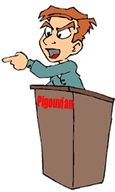
Grades 9-12

Don't have an account yet? Sign up for free
Don't have an account yet? Sign up for free


Hot debate and arguments galore whirl around this question: "Which economic approach is the most efficient and fair to resolve utility issues surrounding the use of common or public property?" This lesson will explore, examine and analyze this perplexing question by engaging in an open-ended role play simulation.
 The debate among economists rages stronger than ever: whether the Coase Theorem or a Pigouvian tax works more effectively in cases involving environmental use and misuse. "Pigouvians" accuse "Coasians" of being right-wing radicals who would provide the rich and powerful with unfair advantages in the use of common or public property. "Coasians" accuse "Pigouvians" of disloyalty to the fundamental economic principle that well-defined property rights always bring about the most efficient use of a resource. Economists must decide which theorem or problem of how well the property rights are defined. They must also decide what, if any, are the transaction costs, and how many people are actually touched by the problem. Using on-line resources to gather information, the students will engage in a simulation activity designed to help them examine both sides of the controversy. They will learn about public and private property, the tragedy of the commons, and externality issues while assuming the role of New Sense, Inc. or the Fish Till You Drop Association.
The debate among economists rages stronger than ever: whether the Coase Theorem or a Pigouvian tax works more effectively in cases involving environmental use and misuse. "Pigouvians" accuse "Coasians" of being right-wing radicals who would provide the rich and powerful with unfair advantages in the use of common or public property. "Coasians" accuse "Pigouvians" of disloyalty to the fundamental economic principle that well-defined property rights always bring about the most efficient use of a resource. Economists must decide which theorem or problem of how well the property rights are defined. They must also decide what, if any, are the transaction costs, and how many people are actually touched by the problem. Using on-line resources to gather information, the students will engage in a simulation activity designed to help them examine both sides of the controversy. They will learn about public and private property, the tragedy of the commons, and externality issues while assuming the role of New Sense, Inc. or the Fish Till You Drop Association.
Note: If a student wishes to use this lesson as an independent study project, the following procedures may be followed.

| For a class of 20 | For a class of 30 |
| 4 Fish parts | 6 Fish parts |
| 1 Bear part | 2 Bear parts |
| 1 Waterfowl part | 2 Waterfowl parts |
| 5 Fisherpeople | 7 Fisherpeople |
| 4 Traders | 6 Traders |
| 5 New Sense, Inc. people | 7 New Sense, Inc. people |
Instruct the groups to read and discuss their articles. Check for understanding as necessary. Be available to each group to provide help. Then, using the information they have studied, the studnets should prepare a conclusion that would support their position and end the play. They should be given 45 minutes to an hour to complete this portion of the lesson.
Once the activity is complete and you have had a class discussion, you could have the students do the following:
View Interactive Activity
1. Teachers may use any of the essay suggestions for assessment purposes.
2. Teachers may use the classroom presentation suggestions for assessment purposes.

Grades 9-12

Grades 9-12

Grades 9-12

Grades 9-12
